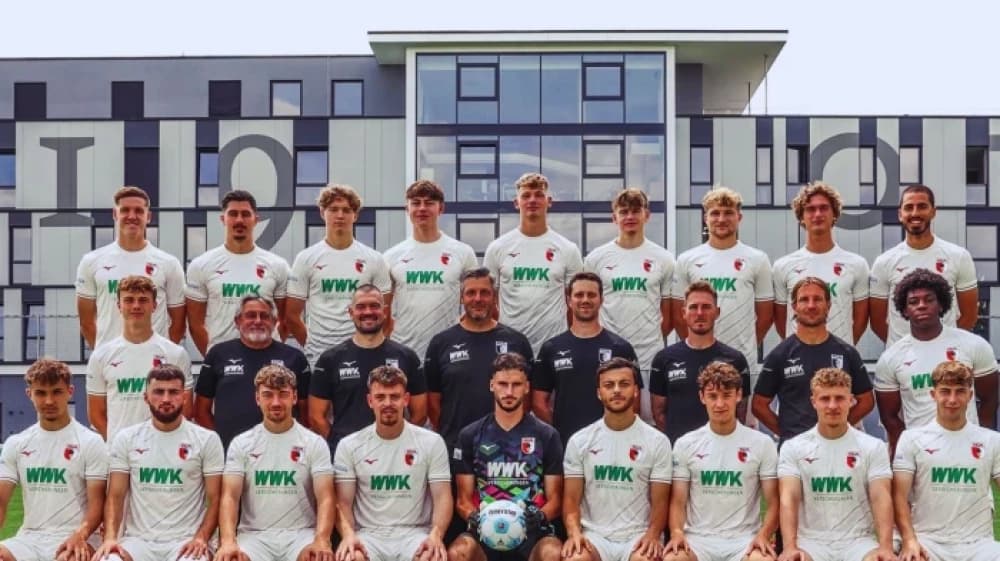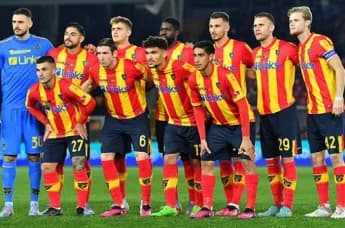From humble beginnings in the lower leagues to becoming a Bundesliga mainstay, FC Augsburg’s story is one of perseverance, smart management, and unwavering fan support.
Introduction
Fußball-Club Augsburg 1907 e. V., commonly known as FC Augsburg or FCA, is a professional football club based in Augsburg, Bavaria. Competing in Germany’s top-tier Bundesliga, the club has carved out a unique identity in German football, marked by its resilience, community ties, and steady rise from obscurity to prominence. Founded in 1907, FC Augsburg has grown into the largest football club in the Swabian region, boasting over 27,000 members. Its journey—from lower-division struggles to Bundesliga stability and European competition—reflects a story of determination and smart management.
Historical Foundations
FC Augsburg’s origins trace back to 1907, when it was established as Fußballklub Alemannia Augsburg. The club underwent several name changes, including BC Augsburg from 1921 to 1969, before adopting its current identity. For much of its early history, Augsburg languished in the lower tiers of German football, oscillating between the second and third divisions.
A significant turning point came in 1969, when BC Augsburg merged with the football department of TSV Schwaben, a local rival, to form FC Augsburg. This merger, facilitated by then-mayor Hans Breuer, aimed to consolidate resources and create a stronger footballing entity. Despite initial resistance from some factions, the merger laid the foundation for the club’s future growth.
Rise Through the Ranks
FC Augsburg’s journey to the Bundesliga was anything but straightforward. The club spent decades in the lower divisions, facing financial difficulties and occasional relegations. A particularly challenging period came in the early 2000s when Augsburg was relegated to the fourth division, a low point that tested the resolve of its supporters.
However, the club’s resilience shone through. Under the leadership of chairman Walther Seinsch, Augsburg stabilized financially and began its ascent. Promotions from the Regionalliga (third tier) to the 2. Bundesliga (second tier) in 2006 marked the start of a new era. The club’s persistence paid off in 2011 when it secured promotion to the Bundesliga for the first time in its history, a milestone that brought top-flight football to Augsburg.
Bundesliga and European Adventures
Since its promotion, FC Augsburg has established itself as a competitive Bundesliga side. The club’s most remarkable achievement came in the 2014–15 season, when it finished fifth in the league—its highest-ever position—and qualified for the UEFA Europa League.
Augsburg’s debut in European competition during the 2015-16 season was a historic moment. The team advanced to the Round of 32, where it faced Liverpool. Despite a narrow 1-0 aggregate defeat, the campaign showcased Augsburg’s ability to compete on the continental stage.
In the Bundesliga, Augsburg has consistently avoided relegation, often finishing in the mid-table. The club’s ability to punch above its weight, despite having one of the league’s smaller budgets, is a testament to its efficient management and strong team spirit.
Rivalries and Key Matches
FC Augsburg’s rise has fueled several intense rivalries, both local and regional. Matches against TSV 1860 Munich and FC Ingolstadt are particularly heated, with bragging rights in Bavarian football at stake. The club’s encounters with Bayern Munich, Germany’s footballing powerhouse, are also highly anticipated, with Augsburg occasionally springing surprises, such as their 1-0 victory in the 2013–14 season that ended Bayern’s 53-match unbeaten run.
Infrastructure and Youth Development
FC Augsburg’s modern infrastructure has played a pivotal role in its success. The WWK ARENA, opened in 2009, is a state-of-the-art stadium with a capacity of 30,660. It provides a vibrant matchday atmosphere and has become a symbol of the club’s growth.
The club’s commitment to youth development is evident in its Paul-Renz-Akademie, a top-tier training facility that nurtures young talent. Augsburg’s academy has produced several players who have gone on to make an impact in the Bundesliga and beyond. The club’s emphasis on integrating youth players into the first team ensures a steady pipeline of talent.
Fanbase and Community Engagement
FC Augsburg’s fanbase is the lifeblood of the club. Known for their loyalty and passion, Augsburg supporters have stood by the team through thick and thin. The club’s deep connection with its local community is reflected in its outreach programs, charitable initiatives, and efforts to promote inclusivity in football.
The WWK Arena is a hub of fan activity, with the Ulrich-Biesinger-Tribüne (a standing terrace) serving as the heart of the stadium’s electric atmosphere. Chants like “Augsburg hält zusammen” (Augsburg Sticks Together) embody the unity and resilience of the club and its supporters.
Present and Future Ambitions
Today, FC Augsburg continues to compete in the Bundesliga, balancing the challenges of financial constraints with the ambition to grow. The club’s focus remains on maintaining its top-flight status, developing young talent, and potentially pushing for European qualification in the future.
Augsburg’s leadership, including American investor David Blitzer, who acquired a 45% stake in the club in 2021, is committed to sustainable growth. By investing in infrastructure, scouting, and youth development, the club aims to build a solid foundation for long-term success.
Conclusion
FC Augsburg’s journey from the lower leagues to the Bundesliga is a story of perseverance, smart management, and unwavering fan support. As the club looks to the future, its ambition to solidify its standing in German football and continue making history remains unwavering. With a passionate fanbase, a strong community connection, and a commitment to growth, FC Augsburg is poised to write the next chapter in its remarkable story.
Introduction
Fußball-Club Augsburg 1907 e. V., commonly known as FC Augsburg or FCA, is a professional football club based in Augsburg, Bavaria. Competing in Germany’s top-tier Bundesliga, the club has carved out a unique identity in German football, marked by its resilience, community ties, and steady rise from obscurity to prominence. Founded in 1907, FC Augsburg has grown into the largest football club in the Swabian region, boasting over 27,000 members. Its journey—from lower-division struggles to Bundesliga stability and European competition—reflects a story of determination and smart management.
Historical Foundations
FC Augsburg’s origins trace back to 1907, when it was established as Fußballklub Alemannia Augsburg. The club underwent several name changes, including BC Augsburg from 1921 to 1969, before adopting its current identity. For much of its early history, Augsburg languished in the lower tiers of German football, oscillating between the second and third divisions.
A significant turning point came in 1969, when BC Augsburg merged with the football department of TSV Schwaben, a local rival, to form FC Augsburg. This merger, facilitated by then-mayor Hans Breuer, aimed to consolidate resources and create a stronger footballing entity. Despite initial resistance from some factions, the merger laid the foundation for the club’s future growth.
Rise Through the Ranks
FC Augsburg’s journey to the Bundesliga was anything but straightforward. The club spent decades in the lower divisions, facing financial difficulties and occasional relegations. A particularly challenging period came in the early 2000s when Augsburg was relegated to the fourth division, a low point that tested the resolve of its supporters.
However, the club’s resilience shone through. Under the leadership of chairman Walther Seinsch, Augsburg stabilized financially and began its ascent. Promotions from the Regionalliga (third tier) to the 2. Bundesliga (second tier) in 2006 marked the start of a new era. The club’s persistence paid off in 2011 when it secured promotion to the Bundesliga for the first time in its history, a milestone that brought top-flight football to Augsburg.
Bundesliga and European Adventures
Since its promotion, FC Augsburg has established itself as a competitive Bundesliga side. The club’s most remarkable achievement came in the 2014–15 season, when it finished fifth in the league—its highest-ever position—and qualified for the UEFA Europa League.
Augsburg’s debut in European competition during the 2015-16 season was a historic moment. The team advanced to the Round of 32, where it faced Liverpool. Despite a narrow 1-0 aggregate defeat, the campaign showcased Augsburg’s ability to compete on the continental stage.
In the Bundesliga, Augsburg has consistently avoided relegation, often finishing in the mid-table. The club’s ability to punch above its weight, despite having one of the league’s smaller budgets, is a testament to its efficient management and strong team spirit.
Rivalries and Key Matches
FC Augsburg’s rise has fueled several intense rivalries, both local and regional. Matches against TSV 1860 Munich and FC Ingolstadt are particularly heated, with bragging rights in Bavarian football at stake. The club’s encounters with Bayern Munich, Germany’s footballing powerhouse, are also highly anticipated, with Augsburg occasionally springing surprises, such as their 1-0 victory in the 2013–14 season that ended Bayern’s 53-match unbeaten run.
Infrastructure and Youth Development
FC Augsburg’s modern infrastructure has played a pivotal role in its success. The WWK ARENA, opened in 2009, is a state-of-the-art stadium with a capacity of 30,660. It provides a vibrant matchday atmosphere and has become a symbol of the club’s growth.
The club’s commitment to youth development is evident in its Paul-Renz-Akademie, a top-tier training facility that nurtures young talent. Augsburg’s academy has produced several players who have gone on to make an impact in the Bundesliga and beyond. The club’s emphasis on integrating youth players into the first team ensures a steady pipeline of talent.
Fanbase and Community Engagement
FC Augsburg’s fanbase is the lifeblood of the club. Known for their loyalty and passion, Augsburg supporters have stood by the team through thick and thin. The club’s deep connection with its local community is reflected in its outreach programs, charitable initiatives, and efforts to promote inclusivity in football.
The WWK Arena is a hub of fan activity, with the Ulrich-Biesinger-Tribüne (a standing terrace) serving as the heart of the stadium’s electric atmosphere. Chants like “Augsburg hält zusammen” (Augsburg Sticks Together) embody the unity and resilience of the club and its supporters.
Present and Future Ambitions
Today, FC Augsburg continues to compete in the Bundesliga, balancing the challenges of financial constraints with the ambition to grow. The club’s focus remains on maintaining its top-flight status, developing young talent, and potentially pushing for European qualification in the future.
Augsburg’s leadership, including American investor David Blitzer, who acquired a 45% stake in the club in 2021, is committed to sustainable growth. By investing in infrastructure, scouting, and youth development, the club aims to build a solid foundation for long-term success.
Conclusion
FC Augsburg’s journey from the lower leagues to the Bundesliga is a story of perseverance, smart management, and unwavering fan support. As the club looks to the future, its ambition to solidify its standing in German football and continue making history remains unwavering. With a passionate fanbase, a strong community connection, and a commitment to growth, FC Augsburg is poised to write the next chapter in its remarkable story.







